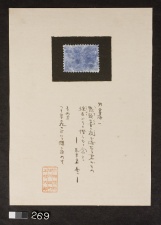Difference between revisions of "Tsuki kusa (Dayflower) - center (269 C)"
Jump to navigation
Jump to search
(username removed) |
|||
| Line 22: | Line 22: | ||
! scope="row"|Dyestuff (Japanese common name) | ! scope="row"|Dyestuff (Japanese common name) | ||
| つき草 : Tsuki kusa | | つき草 : Tsuki kusa | ||
| + | |- | ||
| + | ! scope="row"|Dyestuff (English common name) | ||
| + | | Dayflower | ||
|- | |- | ||
! scope="row"|Dyestuff (botanical name) | ! scope="row"|Dyestuff (botanical name) | ||
Revision as of 08:50, 24 June 2020
| Museum number | 269 |
|---|---|
| Uemura number / title | ; "Haze-some 25" |
| Folder location | 4th shelf |
| Sample location | center (269 C) |
| Fiber type | silk |
| Color | light blue stains |
| Dyestuff (Japanese common name) | つき草 : Tsuki kusa |
| Dyestuff (English common name) | Dayflower |
| Dyestuff (botanical name) | Commelina communis L. |
| Plant part | flower / fresh |
| Dyestuff extraction | flower juice was rubbed onto the fabric |
| Auxiliary agent in dye bath | - |
| Mordant | - |
| Other auxiliary agent | - |
| Uemura's notes | The plant was read in a Japanese classic poem in the Manysh () , volume 7, from the 7th -8th century AD: |
| Uemura's date | Kyoto Murasakino |
